[I]Last Edit: 7/13/2010 9:10PM - Corrected some technical errors & added clarification regarding the bridge tied load & differential signals.
Since the CD43 head unit is a hot topic, and there seems to be a lot of confusion about what it can & cannot do, I took the time to get some answers. I too was confused by the wide variety of information about it, so I will share my observations. Some of this is actually pertinent to all head units / amplification electronics as well.
Depending on who you ask:
1 - The unit has unbalanced or balanced signals
2 - These can or cannot be used to drive speakers directly
3 - It will overheat if used to drive speakers
4 - The amp's output stages are special pre-amp stages
5 - The CD43 has superior SQ to most other HUs
6 - You can or cannot run the outputs to pre-amp inputs
The reality is:
1 - Outputs are "pseudo-balanced." Technically, it is known as a Bridge-Tied Load setup. They carry a common-mode voltage of ~0.5*Vsupply, and the - output terminal is inverted relative to the + terminal. It is not a true balanced setup because there is no dedicated neutral line that they are referenced against, and it turns out that they possess poor asymmetry (see extra stuff at the end).
Here is the CD43 being bench tested. The scope is measuring CH1+ & CH1- on the two traces. The supply voltage is 13.0V and I am running a CD with a 1000Hz test tone. It is well suited for use with input devices that use a differential input, but under no circumstances should one of them be connected to an input where the - terminal goes to ground. In the case of a differential input, whatever is receiving this will be amplifying the DIFFERENCE between the two signals, not their absolute value (notice that it is offset by +6.4V...you wouldn't want to amplify DC). This offset is necessary since the negative half of signals won't exist on a 0-14V system. Think of it as a signal that would otherwise be -6.5V to +6.5V, but shifted up +6.5V so it occupies a 0-13V range.
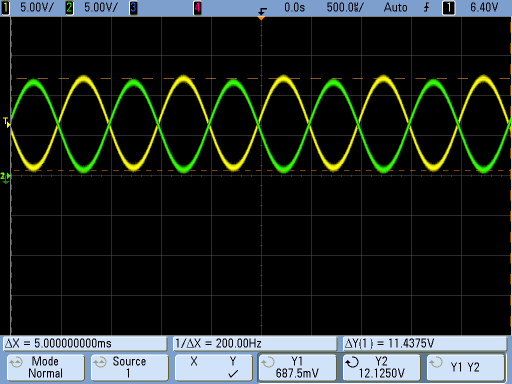
2 - You absolutely CAN run speakers directly from the head unit. See section 3 for concerns in this respect. The outputs come from two ST Microelectronics TDA7376B audio amplifier IC's. They are completely standard 2-channel amp ICs with the same poopy performance of the amp ICs found in every other semi-modern head unit. They are rated to put out a maximum of 40W per channel, but by the time you hit 24W the total harmonic distortion is already 10% if you are running at 14.4V.
The datasheet is here, if you are interested:
3 - There may be some truth to the overheating part. The amp chips are mounted to a small copper plate with NO thermal grease. That is a pretty sub-par setup for thermal management. I added some grease since I have access to good stuff in the labs at work. Since I worked as a thermal engineer, I am pretty anal about this stuff. You can see a little bit of the grease I added squeezing out in this pic...the chips should be a bit happier now.
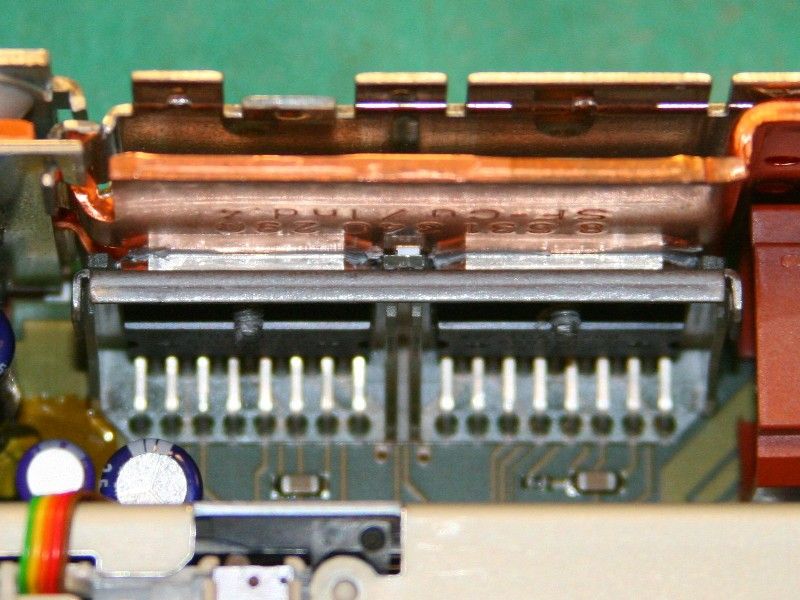
4 - The output stages are nothing special. In fact, the TDA7376B is less powerful than many newer amp ICs. Most newer HUs use the TDA7386 which is a 4-channel amplifier that puts out marginally more power with the same exact distortion behavior. Pioneer, among others, uses this chip but relabels it with their own PN.
Here is the performance of the ethereal CD43 head unit lol. Truly, if you are going to run speakers from it, you had better not run more than ~10W. The spike in distortion is due to signal clipping...you just cannot run much power into a 4 Ohm load with a supply voltage of 14.4V. The lower your battery voltage, the less power you can run without clipping.
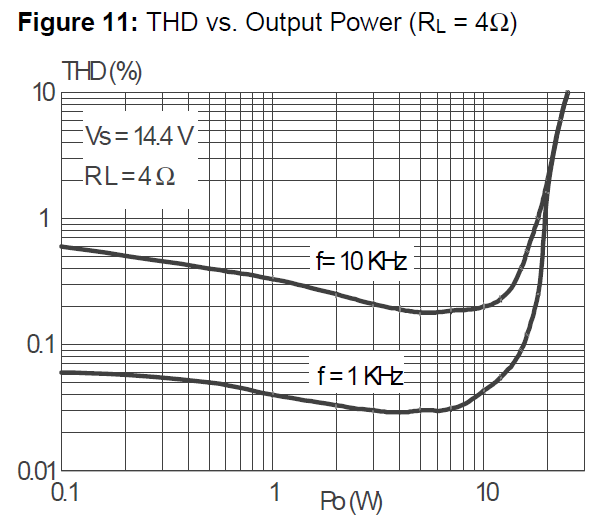
Dedicated amplifiers can supply a lot more power without clipping because they have internal power supplies (switching boost converters) that typically have power rails at +/-22V (typical of 50-60W channels @ 4 Ohms) to 55V (250W channel @ 4 Ohms).
5 - Sound quality...you should have figured this out by now. The CD43 is just another head unit.
6 - You might be able to run the outputs to pre-amp inputs. It really depends on the hardware. As long as you don't turn the CD43 up high enough to cause clipping in an amp's input stages you should be fine. If the inputs' - terminals are connected to ground, do NOT connect a signal line to them or you will blow the CD43 amp chip. You would end up just leaving one of the outputs floating & ground the - input. This is sub-par though since there is NO noise rejection. You really want to run these to a device that has a differential input so that any noise induced into the lines (in common) gets rejected. You'll probably get nasty alternator & ignition noise if you don't.
Conclusions:
So the CD43 is nothing special (in terms of the output, it is slightly inferior to some newer HUs). It is probably so pricey because it says BMW on it and nothing more. I don't regret dropping $300 on it because I want a stock head unit that can play CDs. Options are limited in this regard, especially with an E30. As with any head unit, it really is best to run it with external amplification. When you run the HU outputs to one, VERY little power is dissipated so you stay on the nice low portion of the THD plot above. Hopefully nobody will get mad at me for bashing it, or think that I am calling them dumb for buying it. I bought it too, so I am certainly no smarter than you!
Don't take this as some sort of reason to avoid the CD43. Truly, it performs exactly the same as every other HU in most practical respects. You should run it with an amplifier, just like all others. The internal amplifier sucks just as much as the one found in other HUs. Basically, if you want a nice stock radio that can play CDs and supports a changer/iBus, go for the CD43. I have no regrets.
Someone mail me a Nakamichi HU, I want to see if they are the same as everyone else (I bet they are). I won't hurt it lol.
Extra Notes: Somewhat Interesting, Likely Confusing
A lot of amplifier user's manuals tell you to turn the HU volume to ~75% when tuning the amp gain. There is a very good reason for this, which has to do with the following information.
The ground level is the ticked horizontal line with the green "2" & ground symbol pointing to it. The differential voltage (difference between yellow & green) is in the lower-right in the box with the deltaY(1)=X.XXXV.
Low-volume differential outputs (13V supply):
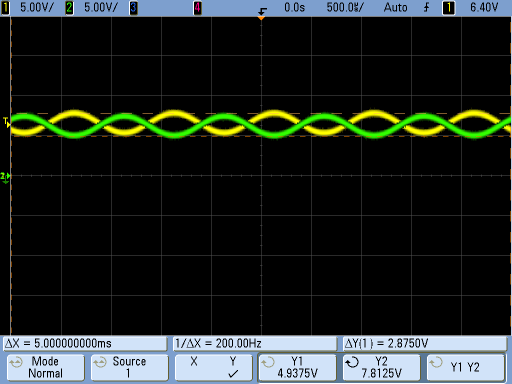
Turning the volume up a little...
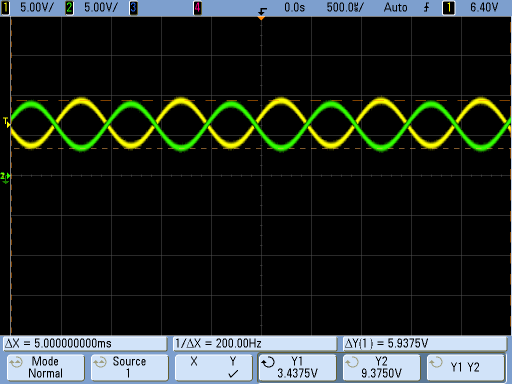
More volume...

Onset of clipping...right around ~75% of maximum (I was counting clicks on the volume knob). Keep in mind that the CD source had a 0dB test signal on it which basically has the highest audio level you can get on a CD.
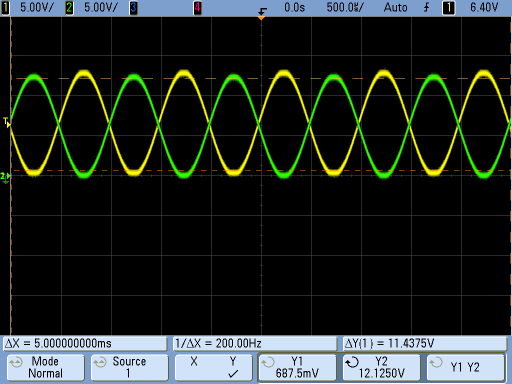
Up ONE click from the previous shot. Clipping a lot more.
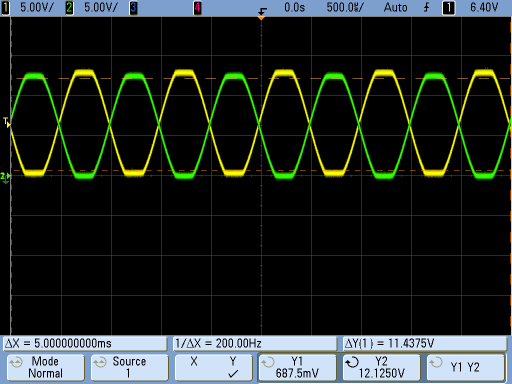
And the volume is maxed out. Ever wonder why it sounds like ass when you turn it up all the way? Well, the CD is playing a SINE signal, but the output looks like a digital data line lol. You would need to be running ~22V in the car to make it look right.
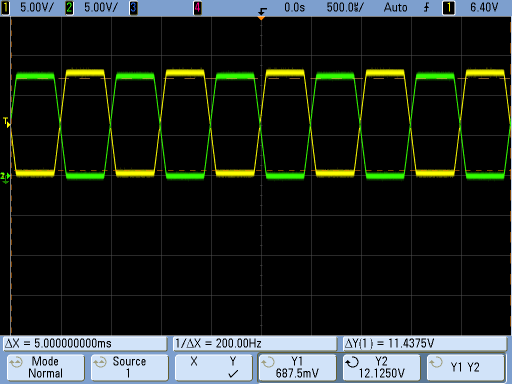
If you read this before, there was the section about the offset between the BTL outputs. It turns out that the huge offset was due to the way I had the oscilloscope set up...the actual offset is ~100mV (spec sheet says it can be up to 125mV), and that is not a big deal. 125mV into a 4-Ohm load is only ~16mW (0.016W). So, forget about anything you read previously. The offset is fine.
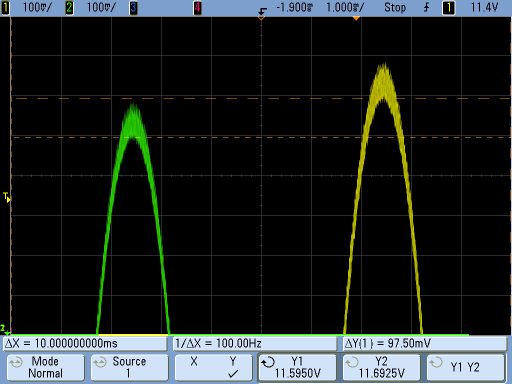
Hopefully this was interesting. Cheers.
Since the CD43 head unit is a hot topic, and there seems to be a lot of confusion about what it can & cannot do, I took the time to get some answers. I too was confused by the wide variety of information about it, so I will share my observations. Some of this is actually pertinent to all head units / amplification electronics as well.
Depending on who you ask:
1 - The unit has unbalanced or balanced signals
2 - These can or cannot be used to drive speakers directly
3 - It will overheat if used to drive speakers
4 - The amp's output stages are special pre-amp stages
5 - The CD43 has superior SQ to most other HUs
6 - You can or cannot run the outputs to pre-amp inputs
The reality is:
1 - Outputs are "pseudo-balanced." Technically, it is known as a Bridge-Tied Load setup. They carry a common-mode voltage of ~0.5*Vsupply, and the - output terminal is inverted relative to the + terminal. It is not a true balanced setup because there is no dedicated neutral line that they are referenced against, and it turns out that they possess poor asymmetry (see extra stuff at the end).
Here is the CD43 being bench tested. The scope is measuring CH1+ & CH1- on the two traces. The supply voltage is 13.0V and I am running a CD with a 1000Hz test tone. It is well suited for use with input devices that use a differential input, but under no circumstances should one of them be connected to an input where the - terminal goes to ground. In the case of a differential input, whatever is receiving this will be amplifying the DIFFERENCE between the two signals, not their absolute value (notice that it is offset by +6.4V...you wouldn't want to amplify DC). This offset is necessary since the negative half of signals won't exist on a 0-14V system. Think of it as a signal that would otherwise be -6.5V to +6.5V, but shifted up +6.5V so it occupies a 0-13V range.

2 - You absolutely CAN run speakers directly from the head unit. See section 3 for concerns in this respect. The outputs come from two ST Microelectronics TDA7376B audio amplifier IC's. They are completely standard 2-channel amp ICs with the same poopy performance of the amp ICs found in every other semi-modern head unit. They are rated to put out a maximum of 40W per channel, but by the time you hit 24W the total harmonic distortion is already 10% if you are running at 14.4V.
The datasheet is here, if you are interested:
3 - There may be some truth to the overheating part. The amp chips are mounted to a small copper plate with NO thermal grease. That is a pretty sub-par setup for thermal management. I added some grease since I have access to good stuff in the labs at work. Since I worked as a thermal engineer, I am pretty anal about this stuff. You can see a little bit of the grease I added squeezing out in this pic...the chips should be a bit happier now.

4 - The output stages are nothing special. In fact, the TDA7376B is less powerful than many newer amp ICs. Most newer HUs use the TDA7386 which is a 4-channel amplifier that puts out marginally more power with the same exact distortion behavior. Pioneer, among others, uses this chip but relabels it with their own PN.
Here is the performance of the ethereal CD43 head unit lol. Truly, if you are going to run speakers from it, you had better not run more than ~10W. The spike in distortion is due to signal clipping...you just cannot run much power into a 4 Ohm load with a supply voltage of 14.4V. The lower your battery voltage, the less power you can run without clipping.

Dedicated amplifiers can supply a lot more power without clipping because they have internal power supplies (switching boost converters) that typically have power rails at +/-22V (typical of 50-60W channels @ 4 Ohms) to 55V (250W channel @ 4 Ohms).
5 - Sound quality...you should have figured this out by now. The CD43 is just another head unit.
6 - You might be able to run the outputs to pre-amp inputs. It really depends on the hardware. As long as you don't turn the CD43 up high enough to cause clipping in an amp's input stages you should be fine. If the inputs' - terminals are connected to ground, do NOT connect a signal line to them or you will blow the CD43 amp chip. You would end up just leaving one of the outputs floating & ground the - input. This is sub-par though since there is NO noise rejection. You really want to run these to a device that has a differential input so that any noise induced into the lines (in common) gets rejected. You'll probably get nasty alternator & ignition noise if you don't.
Conclusions:
So the CD43 is nothing special (in terms of the output, it is slightly inferior to some newer HUs). It is probably so pricey because it says BMW on it and nothing more. I don't regret dropping $300 on it because I want a stock head unit that can play CDs. Options are limited in this regard, especially with an E30. As with any head unit, it really is best to run it with external amplification. When you run the HU outputs to one, VERY little power is dissipated so you stay on the nice low portion of the THD plot above. Hopefully nobody will get mad at me for bashing it, or think that I am calling them dumb for buying it. I bought it too, so I am certainly no smarter than you!
Don't take this as some sort of reason to avoid the CD43. Truly, it performs exactly the same as every other HU in most practical respects. You should run it with an amplifier, just like all others. The internal amplifier sucks just as much as the one found in other HUs. Basically, if you want a nice stock radio that can play CDs and supports a changer/iBus, go for the CD43. I have no regrets.
Someone mail me a Nakamichi HU, I want to see if they are the same as everyone else (I bet they are). I won't hurt it lol.
Extra Notes: Somewhat Interesting, Likely Confusing
A lot of amplifier user's manuals tell you to turn the HU volume to ~75% when tuning the amp gain. There is a very good reason for this, which has to do with the following information.
The ground level is the ticked horizontal line with the green "2" & ground symbol pointing to it. The differential voltage (difference between yellow & green) is in the lower-right in the box with the deltaY(1)=X.XXXV.
Low-volume differential outputs (13V supply):

Turning the volume up a little...

More volume...

Onset of clipping...right around ~75% of maximum (I was counting clicks on the volume knob). Keep in mind that the CD source had a 0dB test signal on it which basically has the highest audio level you can get on a CD.

Up ONE click from the previous shot. Clipping a lot more.

And the volume is maxed out. Ever wonder why it sounds like ass when you turn it up all the way? Well, the CD is playing a SINE signal, but the output looks like a digital data line lol. You would need to be running ~22V in the car to make it look right.

If you read this before, there was the section about the offset between the BTL outputs. It turns out that the huge offset was due to the way I had the oscilloscope set up...the actual offset is ~100mV (spec sheet says it can be up to 125mV), and that is not a big deal. 125mV into a 4-Ohm load is only ~16mW (0.016W). So, forget about anything you read previously. The offset is fine.

Hopefully this was interesting. Cheers.






Comment